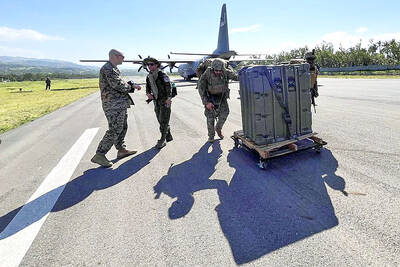With many people under tremendous pressure to complete projects before the Lunar New Year next month, a Taipei doctor has urged the public to look out for symptoms of Bell’s palsy.
Taipei City Hospital’s Yangming Branch traditional Chinese medicine physician Lin Chia-ying (林佳瑩) said increased workload for students and employees and sudden drops in temperature at this time of year have driven up the number of people experiencing partial facial paralysis, such as a drooping eye or mouth, inability to close the affected eye and uncontrollable drooling.
“These people included a 48-year-old man surnamed Chen (陳), who suddenly exhibited a sagging mouth and an inability to shut his left eye after working overtime on several consecutive days, as well as a 60-year-old woman who also experienced similar symptoms after battling a prolonged cold and increased workload at the same time,” Lin said.
Lin said that as these patients did not exhibit numbness or impeded movement of the limbs, she was able to rule out stroke and diagnosed them with facial paralysis, with the most common type being Bell’s palsy.
Bell’s palsy affects approximately 15 to 30 out of every 100,000 people and can occur in anyone, regardless of their age and gender, Lin said.
The exact cause of the disease remains unknown, Lin said, but most sufferers experience flu-like symptoms, work overtime or are studying for exams before they lapse into facial paralysis.
Lin advised people suffering from Bell’s palsy to massage their face daily to improve blood circulation, engage in facial muscle exercises, such as frowning, whistling and ballooning one’s cheeks, and to keep their face warm to avoid poor blood flow.
“They can also resort to a neurologist and undergo acupuncture treatments within the first three months after the onset of Bell’s palsy symptoms, which can cure nearly 80 percent of such patients,” Lin said.

Three batches of banana sauce imported from the Philippines were intercepted at the border after they were found to contain the banned industrial dye Orange G, the Food and Drug Administration (FDA) said yesterday. From today through Sept. 2 next year, all seasoning sauces from the Philippines are to be subject to the FDA’s strictest border inspection, meaning 100 percent testing for illegal dyes before entry is allowed, it said in a statement. Orange G is an industrial coloring agent that is not permitted for food use in Taiwan or internationally, said Cheng Wei-chih (鄭維智), head of the FDA’s Northern Center for

LOOKING NORTH: The base would enhance the military’s awareness of activities in the Bashi Channel, which China Coast Guard ships have been frequenting, an expert said The Philippine Navy on Thursday last week inaugurated a forward operating base in the country’s northern most province of Batanes, which at 185km from Taiwan would be strategically important in a military conflict in the Taiwan Strait. The Philippine Daily Inquirer quoted Northern Luzon Command Commander Lieutenant General Fernyl Buca as saying that the base in Mahatao would bolster the country’s northern defenses and response capabilities. The base is also a response to the “irregular presence this month of armed” of China Coast Guard vessels frequenting the Bashi Channel in the Luzon Strait just south of Taiwan, the paper reported, citing a

The Chinese military has built landing bridge ships designed to expand its amphibious options for a potential assault on Taiwan, but their combat effectiveness is limited due to their high vulnerability, a defense expert said in an analysis published on Monday. Shen Ming-shih (沈明室), a research fellow at the Institute for National Defense and Security Research, said that the deployment of such vessels as part of the Chinese People’s Liberation Army (PLA) Navy’s East Sea Fleet signals a strong focus on Taiwan. However, the ships are highly vulnerable to precision strikes, which means they could be destroyed before they achieve their intended

UNDER PRESSURE: The report cited numerous events that have happened this year to show increased coercion from China, such as military drills and legal threats The Chinese Communist Party (CCP) aims to reinforce its “one China” principle and the idea that Taiwan belongs to the People’s Republic of China by hosting celebratory events this year for the 80th anniversary of the end of World War II, the “retrocession” of Taiwan and the establishment of the UN, the Mainland Affairs Council (MAC) said in its latest report to the Legislative Yuan. Taking advantage of the significant anniversaries, Chinese officials are attempting to assert China’s sovereignty over Taiwan through interviews with international news media and cross-strait exchange events, the report said. Beijing intends to reinforce its “one China” principle